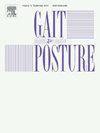Comparison of balance performance, gait, foot function, lower extremity biomechanical alignment and muscle strength in individuals with unilateral and bilateral plantar fasciitis
IF 2.2
3区 医学
Q3 NEUROSCIENCES
引用次数: 0
Abstract
Background
Given the pedal variations in biomechanical effects, chronicity, treatment implications, and foot function and alignment in plantar fasciitis, we aim to compare key parameters between individuals with unilateral and bilateral plantar fasciitis.
Methods
Thirty individuals (15 unilateral and 15 bilateral) were included in the study. Static balance was evaluated with the Single-Leg Stance Test, dynamic balance with The Star Balance Excursion Test, gait with OneStep 3.20 mobile software, foot function with The Foot Function Index (FFI), biomechanical alignment with medial longitudinal arch height, Q angle, and lower extremity muscle length, and muscle strength with a Hand-held Dynamometer.
Results
The unilateral group exhibited superior performance in unaffected side static and posterolateral dynamic balance (p = 0.037; p = 0.039), and in affected side posterior dynamic balance (p = 0.041). Gait double support asymmetry was better in the unilateral group (p = 0.003). Pain, disability, and activity limitation were more pronounced in the bilateral group (p < 0.05). No significant differences were observed between the groups in medial arch height, Q angle, and muscle shortness/flexibility (p > 0.05). The unilateral group had more strength in the affected side's Gluteus Medius and Adductor muscles (p = 0.046; p = 0.011), as well as in the unaffected side's Quadriceps, Iliopsoas, Gluteus Medius, and Adductor muscles (p = 0.018; p = 0.026; p = 0.006; p = 0.026).
Conclusion
Balance, foot function and muscle strength were better in individuals with unilateral plantar fasciitis. We think more specific treatments should be included in the management of individuals with bilateral plantar fasciitis aiming to improve balance, foot function and muscle strength.
比较单侧和双侧足底筋膜炎患者的平衡能力、步态、足部功能、下肢生物力学排列和肌肉力量
背景:考虑到足底筋膜炎患者在生物力学效应、慢性、治疗意义、足部功能和方向方面的差异,我们的目的是比较单侧和双侧足底筋膜炎患者的关键参数。方法30例患者(单侧15例,双侧15例)纳入研究。使用单腿站立测试评估静态平衡,使用Star平衡偏移测试评估动态平衡,使用OneStep 3.20移动软件评估步态,使用足功能指数(FFI)评估足部功能,使用内侧纵弓高度、Q角和下肢肌肉长度进行生物力学校准,使用手摇测力仪评估肌肉力量。结果单侧组在未受影响侧静态平衡和后外侧动态平衡方面表现较好(p = 0.037;P = 0.039),患侧后侧动态平衡(P = 0.041)。单侧组步态双支撑不对称性较好(p = 0.003)。双侧组疼痛、残疾和活动受限更为明显(p <; 0.05)。组间内弓高度、Q角、肌肉短度/柔韧性无显著差异(p >; 0.05)。单侧组患侧臀中肌和内收肌力量更大(p = 0.046;p = 0.011),以及未受影响一侧的股四头肌、髂腰肌、臀中肌和内收肌(p = 0.018;p = 0.026;p = 0.006; = 0.026页)。结论单侧足底筋膜炎患者的平衡能力、足部功能和肌力较好。我们认为,对于双侧足底筋膜炎患者,应采取更具体的治疗措施,以改善平衡、足部功能和肌肉力量。
本文章由计算机程序翻译,如有差异,请以英文原文为准。
求助全文
约1分钟内获得全文
求助全文
来源期刊

Gait & posture
医学-神经科学
CiteScore
4.70
自引率
12.50%
发文量
616
审稿时长
6 months
期刊介绍:
Gait & Posture is a vehicle for the publication of up-to-date basic and clinical research on all aspects of locomotion and balance.
The topics covered include: Techniques for the measurement of gait and posture, and the standardization of results presentation; Studies of normal and pathological gait; Treatment of gait and postural abnormalities; Biomechanical and theoretical approaches to gait and posture; Mathematical models of joint and muscle mechanics; Neurological and musculoskeletal function in gait and posture; The evolution of upright posture and bipedal locomotion; Adaptations of carrying loads, walking on uneven surfaces, climbing stairs etc; spinal biomechanics only if they are directly related to gait and/or posture and are of general interest to our readers; The effect of aging and development on gait and posture; Psychological and cultural aspects of gait; Patient education.
 求助内容:
求助内容: 应助结果提醒方式:
应助结果提醒方式:


